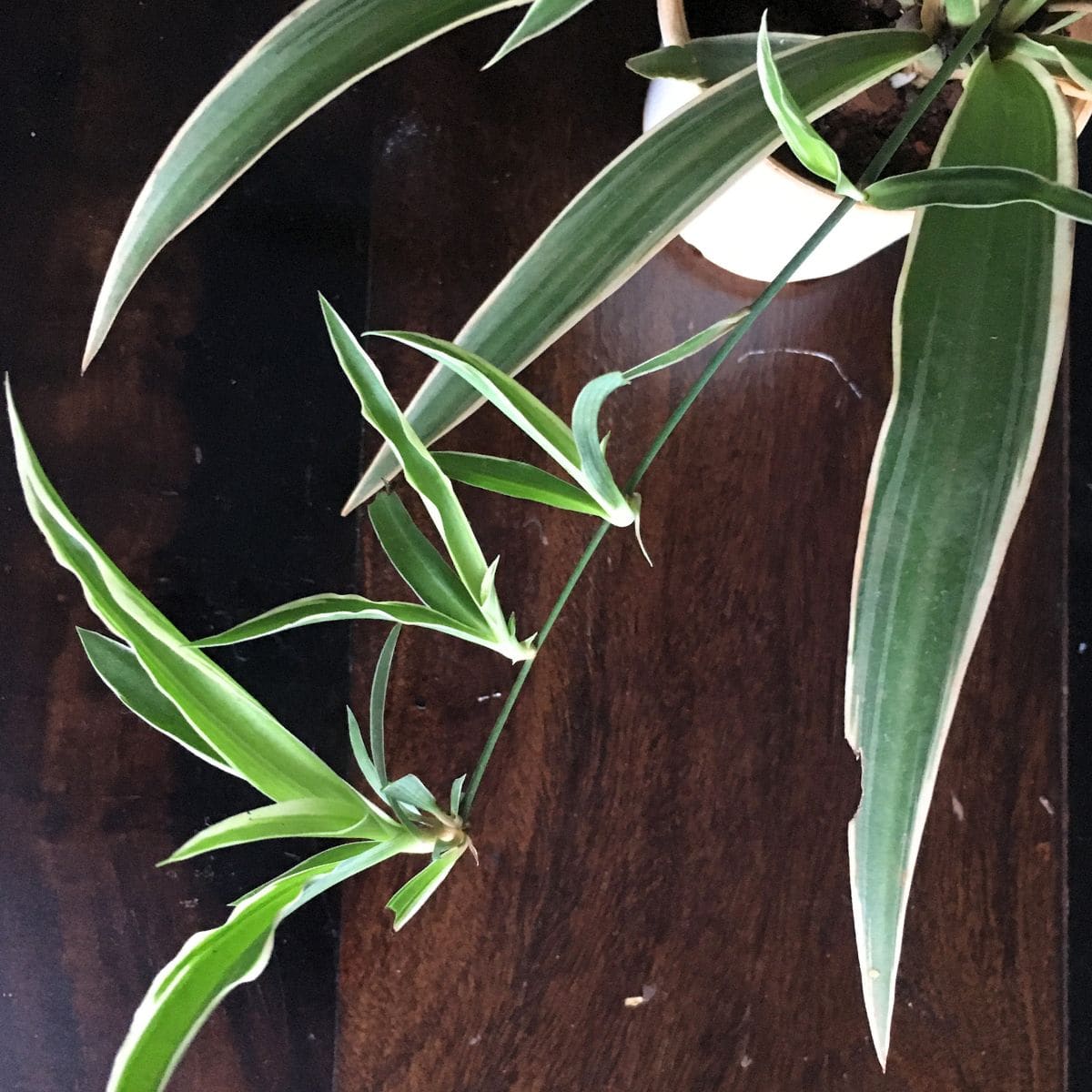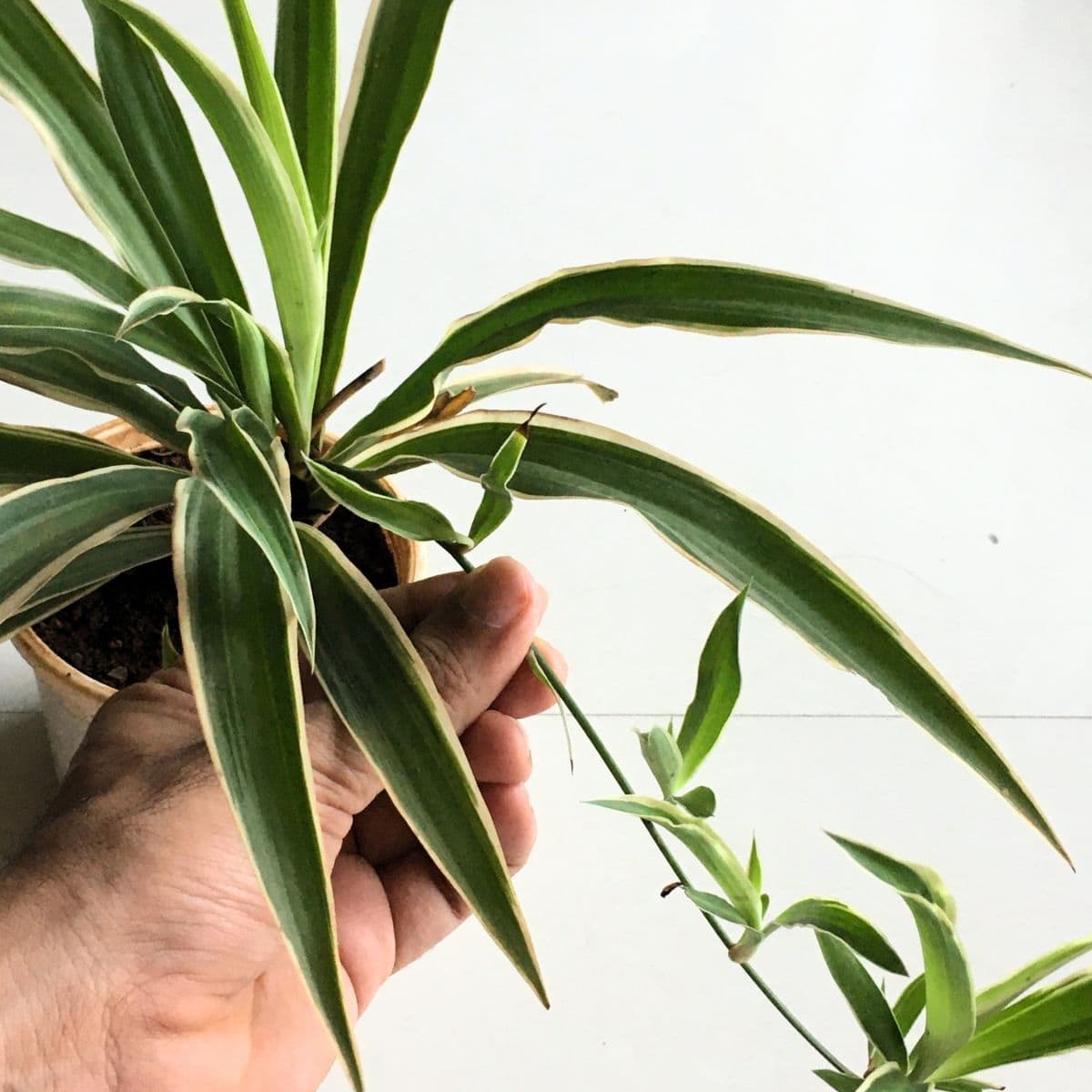Spider plants can be propagated in many ways, but you can’t propagate them with leaves.
Unlike other indoor plants, the Spider plant leaves are not meant for propagation. They don’t produce roots when kept in water or soil. So, even if you try traditional rooting methods using the leaves, it won’t give you favorable results.
Let’s learn more about this topic and the propagation methods in the following guide.

Jump To:
Can You Propagate Spider Plant From Leaf?
No, you can’t propagate Spider plants from the leaf.
Spider plant leaves don’t produce any adventitious roots at the bottom. These roots are essential for supplying nutrients and water to the different parts of the plants.
We often see such roots on succulent varieties of plants like the Jade and Aloe Vera plant. If you try to root the leaves of these plants, you might see new roots being formed under the leaves after successful propagation.

That said, leaf propagation is one of the most difficult ways to produce new plants. It doesn’t have a high success rate, and it’s better to rely on other propagation techniques.
Suitable Propagation Methods For Spider Plant
Even though leaf propagation is not possible with the Spider plant, you can use the following methods for better results.
1. Soil Propagation Through Spider Plant Babies
When the plant matures, it produces a long stem with baby spider plants. These small plants are beneficial for the propagation process.
However, wait for them to produce at least a few roots at the bottom. This way, you can ensure the successful propagation of these plants.
If you try to root them without roots, you won’t see new roots being formed after potting them in the soil. Eventually, the plant will not last long, and you will have to repeat the same procedure with new Spiderettes.
Here are some quick steps for soil propagation –
- Collect a few Spider plant pups from the main stem.
- Prepare 2-3 small pots with potting mix.
- Gently place the pups in the pots and water them well.
That’s all! Now, all you need to do is wait for 4-5 days until the topsoil dries out. Later, you can water the pots again.
While preparing the pots, make sure there are enough holes at the bottom. Besides, you may add some pebbles to the pot for adequate drainage.
2. Water Propagation
Similar to the soil propagation method, you can root Spider plant babies in water too.
In this method, you will have to place the Spiderettes in a glass of water. However, the pups should have a few roots, as mentioned above. These roots will help soak in sufficient water from the glass.
Moreover, you should change the water occasionally. It helps the plant get fresh water. The stagnant water might contain harmful bacteria, which can easily harm the growth of a new plant. So, you need to be careful and change the water in the glass accordingly.
3. Stem Propagation
This method is the easiest of them all and is pretty similar to the soil propagation method.

Here, you will have to bend the Spider plant pups growing stem towards a comparatively large pot. When it reaches the topsoil of the new pot, put the Spiderettes’ roots in the soil carefully. You will also need to put some part of the stolon in the ground so that it gives enough support to the small plants.
Once you cover them with the soil, water the new pot well. As for the fertilizers, you don’t have to put any fertilizers at this moment. When the small plants begin to thrive, use vermicompost or any natural fertilizers.
Note: When the plant matures, cut the attached stem and allow it to grow independently. You can also repot the plant in a bigger pot if you want.
How Quickly Do Spider Plants Propagate?
It takes up to 2-3 weeks for the Spider plant babies to form mature roots at the bottom. Once these roots are formed, you can remove them from the mother plant and transplant them as needed.
You will see tiny roots being formed on these plants in 3-4 days. If you try to propagate them in this period, the plants may not do well in new pots.
What To Do With Spider Plant Puppies?
The mother plant can produce several baby plants, depending on its size and growing conditions. But sometimes, it’s challenging to manage so many plants in your indoor garden.
So, here are some of the things to try –
1. Keep Growing Them
In general, the Spider plant doesn’t take up too much space in the pot. It doesn’t spread a lot, either. So, you can still keep them in the same planter and continue growing them with proper care.
When they outgrow the space, you can think of different options, i.e., pruning and transplanting.
2. Gift Them To Your Friends and Relatives
Gifting is probably the best option to deal with the excess Spider plants.
Prepare a few pots of Spider plants by transplanting the pups into smaller pots. The transplantation process is fairly easy, as you need to cut the new plants from the stem and put them in the fresh pot.
For gifting, you can choose decorative pots, which are easily available on the market.
Important: Even though you need small pots for this process, you must select pots with drainage holes. Other than that, don’t forget to water the plants after transplanting them to these new pots.
3. Get Rid Of Unwanted Plants
In most cases, you don’t have to choose this option. But if you don’t have any other choice, it’s better to get rid of these plants entirely.
Of course, you must ensure the mother plant is doing well in its pot and regularly producing new stems. It’s an indication that the plant is in mint condition.
Once confirmed, you can safely remove the Spiderettes from the main plant.
In addition, you may also plant these babies in a local garden but do take the required permission before planting them.
If you don’t have any other choice, put them in the compost bin, including the stem. It will allow you to repurpose them properly.
FAQs
Offset propagation is by far the easiest propagation method in Spider plants.
Spider plants can’t be propagated using the leaf propagation method. So, there is no point in putting them in water.
Instead, opt for other methods like soil, water, or offshoot propagation. These methods are more effective in getting a new spider plant in your pot.
You can cut the stem growing a few Spider plant babies. It is an ideal method to propagate the plant.
Other than that, you can’t propagate this plant by cutting its leaves or roots.
No, it won’t help much when you plant a Spider plant without roots. The plant needs a continuous source of resources to thrive in the pot. So, it should have a few roots to carry out all the required activities.
It takes about a week or two for the plant to grow roots. However, be patient for the natural growth, as it depends on other factors such as weather conditions, nutrient availability, etc.

Leave a Reply